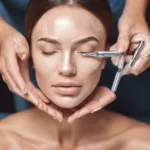29 November 2023
Discover the Benefits, Risks, and Procedure of Dermaplaning
In the pursuit of flawless skin, individuals are constantly seeking innovative and effective skincare treatments. Dermaplaning, a minimally invasive procedure that involves shaving away the top layers of skin, has gained popularity for its ability to reveal brighter, smoother skin. This article explores the world of dermaplaning, delving into its benefits, risks, and the step-by-step procedure involved.
What Is Dermaplaning?
Dermaplaning is a skincare treatment where a dermatologist or healthcare provider uses a handheld surgical device called a dermatome to gently shave off thin layers of skin and hair. This procedure can be performed on specific problem areas or the entire face. It is often used to reduce the appearance of fine lines, wrinkles, and acne scars.
Dermaplaning vs. Dermabrasion vs. Microdermabrasion: What’s the Difference?
While dermaplaning, dermabrasion, and microdermabrasion all involve removing the top layers of skin, there are distinct differences between these procedures. Microdermabrasion utilizes microcrystals or a diamond-tipped device to exfoliate the skin, followed by a suctioning process. Dermabrasion, on the other hand, removes skin layers using an electric rotating brush, producing more dramatic results. Dermaplaning, with its scalpel-like dermatome, allows for deeper exfoliation and can remove both skin and hair.
Benefits of Dermaplaning
Dermaplaning offers several potential benefits, including reducing the appearance of fine lines, minimizing acne scars and pitted skin, brightening dull and dry skin, removing unwanted hair, improving skin texture, treating sun-damaged skin, and allowing for deeper absorption of skincare products. Additionally, dermaplaning can serve as a preparatory step for other skincare treatments or surgical procedures.
Who Is Dermaplaning Right For?
Dermaplaning is suitable for individuals looking to improve the texture and appearance of their skin. It is particularly beneficial for those with sun-damaged skin, signs of skin aging, and certain skin conditions like rosacea. However, individuals with active acne breakouts, cold sores, skin rashes, burns, moles, or skin tags should avoid dermaplaning.
What Happens Before, During, and After Dermaplaning?
Before a dermaplaning session, a consultation with a dermatologist or aesthetician is necessary to discuss goals and potential risks. Patients may be advised to cleanse their face, remove makeup and skincare products, and avoid certain medications prior to the procedure. During the session, a numbing cream or anesthesia may be applied to minimize discomfort. The dermatome is then used to gently remove the top layers of skin, which is typically painless. After the procedure, skincare products may be applied for deeper penetration, and visible results can be seen immediately. Some temporary side effects may occur, such as redness or sensitivity, which usually fade within three months.
Risks of Dermaplaning
While dermaplaning is generally safe, there are a few potential risks associated with the procedure. These include scarring, nicks and cuts, fever blisters, skin irritation, and thickened skin. However, these risks are relatively rare.
Multiple Dermaplaning Procedures
Dermaplaning results are not permanent, and multiple sessions may be required to maintain the desired effects. Typically, individuals undergo dermaplaning once a month to ensure ongoing improvements in the look and feel of their skin.
Conclusion:
Dermaplaning offers a non-invasive solution for individuals seeking brighter, smoother skin. With its ability to reduce the appearance of fine lines, acne scars, and unwanted hair, dermaplaning has become a popular choice among those looking to enhance their skincare routine. While risks exist, undergoing dermaplaning with a trained professional ensures a safer and more effective experience. For those considering dermaplaning, consulting with a dermatologist is recommended to determine if this procedure is the right fit for their skincare goals.



